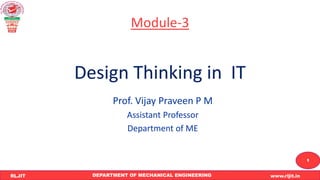The document discusses design thinking in the IT industry. It begins with definitions of information technology and the software development cycle. It then contrasts the traditional waterfall model of software development with the more modern agile methodology. Some key advantages of the agile methodology are that it allows for iterative development, frequent testing and feedback, and flexibility to changing requirements. The document notes that combining design thinking with agile practices can improve collaboration and help ensure teams are solving the right problems. It provides examples of how design thinking applies to areas like business process modeling and agile software development.









































































